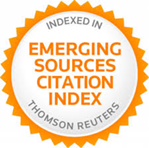Use and semantics of Chernobyl at the contemporary ibero-american theater
DOI:
https://doi.org/10.37536/preh.2023.11.2.1753Keywords:
Chernobyl, Accident, Illness, Memory, Ibero-American TheaterAbstract
This article approaches the nuclear catastrophe occurred in Chernobyl on April 26, 1986. It will be analyzed, from an ideological and cultural point of view, the way in which the memory of the tragedy has been worked on into the Ibero-American Contemporary Theater. It should be noted that the time interval of the study will be limited exclusively to the works and theatrical productions carried out during the present century. Once these initial premises have been established, a specific study corpus will be identified. From here, both the common elements and the differential and specific codes of each of the selected cultural products will be formulated. This analysis will allow the extraction of pertinent keys through which to elaborate a detailed interpretation in reference to the conceptual spaces of use and semantics configured around the Chernobyl place name. It starts, then, from the hypothesis of the existence of a series of significant semes attached to the noun itself, which, over the years, has been expanding its semantic base, becoming a concept with which to work creatively for dramatic writing and for staging. In this sense, we must take into account that the image of Chernobyl, which passes from a purely historical and social sphere to a space constituted by cultural signs, does not maintain a unique or exclusive codification directed by any institution, but rather, seems to respond to psychological and emotional ingredients related to experiences derived from diverse artistic realities.
References
Agüero García, Javier (2017). “La plegaria de Chernóbil: memoria del desastre nuclear en el contexto de un poder agonizante”, Revista Estudios, 35: 24-73. DOI: https://doi.org/10.15517/re.v0i35.31593
Alexievich, Svetlana (2015). Voces de Chernóbil. Crónica del futuro, trad. Ricardo San Vicente. Madrid: Debolsillo.
Alexievich, Svetlana (2002). La plegaria de Chernóbil. Crónica del futuro, trad. Ricardo San Vicente. Barcelona: Casiopea.
Alsedo, Quico (2011). “Chernóbil. 25 años después”, El Mundo. <https://www.elmundo.es/especiales/chernobil/turismo-radiactivo/index.html> (8 de mayo de 2023).
Arbués, Jesús y Marian Pueo (2006). La plegaria de Chernóbil. El amargo sabor del ajenjo. [Adaptación teatral de la obra homónima de Svetlana Alexievich, en traducción al español de Ricardo San Vicente]. Inédito. Vídeo promocional: <https://www.youtube.com/watch?v=tVXSZ_Mu9xA> (7 de diciembre de 2021).
Armengol, Joaquim y Evelyn Arévalo (2020). Carrer de Txernóbil. [A partir del libro homónimo de Svetlana Alexievich]. Inédito.
Barthes, Roland (1972). Crítica y verdad. Buenos Aires: Siglo XXI.
Binetti, Andrés (2006). Petit Hotel Chernóbil. Inédito.
Ferrer, Carlos (2014). “Los cisnes de Chernóbil hablan en español”, Radio Prague International. <https://espanol.radio.cz/los-cisnes-de-chernobil-hablan-en-espanol-8302398> (7 de diciembre de 2021).
Gilabert, Javier (2021). “Antonio César Morón: ‘La alarma es el estado óptimo del teatro’”, SecrertOlivo. Cultura andaluza contemporánea. <https://secretolivo.com/index.php/2021/09/02/antonio-cesar-moron-la-alarma-es-el-estado-optimo-del-teatro/> (5 de noviembre de 2022).
Hernández Catalán, Rosario (2010). Chernóbil, paraíso natural. Oviedo: KRK Ediciones.
La Función Teatro y Teatro Vital del Alma (2021). [Programa de mano de Hojas Negras: Bosque Rojo. Chernóbil]. <https://www.editorialnazari.com/noticias/hojas-negras-bosque-rojo-chernobil/> (21 de diciembre de 2021).
Llorente, David (2017). Los cisnes de Chernóbil, prólogo de Carlos Be. Madrid: Antígona.
Lotman, Iuri M. (1996). La semiosfera, I, selección y traducción de Desiderio Blanco. Madrid: Cátedra.
Mercado, Francisco (2020). Una pandemia de errores. Cómo y por qué la mala gestión del Gobierno convirtió a España en campeona del coronavirus. Barcelona: Planeta.
Morón, Antonio César (2021). Hojas Negras: Bosque Rojo, in Teatro de alarma. Granada: Nazarí, 207-253.
Quesada, Juan Diego (2020). “Solos en la hora final”, El País. <https://elpais.com/espana/madrid/2020-05-21/solos-en-la-pandemia-y-en-la-hora-final.html> (21 de diciembre de 2021).
Scher, Edith (2006). “Respiración imposible”, in Alternativa teatral. <http://www.alternativateatral.com/ver_critica.asp?codigo_critica=139> (7 de diciembre de 2021).
Ramos, Servando Anacarsis (2018). La esperanza de un bosque brotando de mi cadáver. [A partir de Voces de Chernóbil y Prometeo encadenado]. Inédito. <https://www.youtube.com/watch?v=VV1f1vnYQ3c> (7 de diciembre de 2021).
Ruiz, Rafa (2020). “Madrid, Chernóbil, virus y radiactividad, el terror a lo invisible”. <https://elasombrario.publico.es/madrid-chernobil-virus-radiactividad-terror-invisible/> (1 de diciembre de 2021).
Todorov, Tzvetan (1970). Introduction à la littérature fantastique. París: Éditions de Seuil.
Valéro, Florence (2019). Attraction. París: Le Cygnes.
Vidal Liy, Macarena (2020). “Regreso a Wuhan”, El País. <https://elpais.com/elpais/2020/05/12/eps/1589273709_271571.html> (21 de diciembre de 2021).
UNIVALLE [Biblioteca Digital]. [Proyecto sobre El idiota de Chernóbil, solicitado a la Vicerrectoría de Investigaciones de Univalle y propuesto por los grupos de investigación Laboratorio Escénico Univalle y Física Teórica del Estado Sólido]. <https://bibliotecadigital.univalle.edu.co/bitstream/handle/10893/14447/3182%20Alejandro%20González.pdf?sequence=1&isAllowed=y> (1 de diciembre de 2021).
Downloads
Published
How to Cite
Issue
Section
License
Copyright (c) 2023 Antonio César Morón

This work is licensed under a Creative Commons Attribution 4.0 International License.








